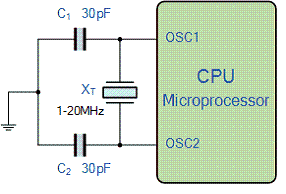A mechanical or electronic device that works on the principles of oscillation is an oscillator. In other words, oscillator can be defined as the periodic fluctuations between two things based on changes in energy. The practical applications of oscillators include Computers, clocks, watches, radios etc.
An example for simple type of mechanical oscillator is a clock pendulum. According to the oscillation within atoms, the atomic clock keeps time. In order to generate signals in computers, wireless receivers and transmitters and audio-frequency equipments, electronic oscillators are mainly used. Particularly it is used in music synthesizers. Different types of electronic oscillators are available. All the electronic oscillators operate according to the same basic principle. An oscillator always employs a sensitive amplifier, whose output signal is fed back to the input signal in phase. Hence, the signal itself regenerates and sustains. This is called as a positive feedback. Thus the oscillator uses a positive feedback for working. This is almost same to the unwanted "howling" in public-address systems.
A quartz crystal determines the frequency at which an oscillator works. When a direct current is applied, these crystals vibrate at a frequency that depends on its thickness value and on the manner in which it is cut from the original mineral rock. To determine the frequency, some oscillators employ combinations of inductors, resistors, and capacitors. But, the use of quartz crystals gives the best stability (constancy of frequency) in oscillators.
 |
| Figure 1 |
.gif) |
| Figure 2 |
.gif) |
| Figure 3 |
.gif) |
| Figure 4 |
Figure 4 shows the equivalent circuit diagram of an oscillator constructed by a Bipolar Junction Transistor (BJT). In the circuit, Xt denotes the crystal.
